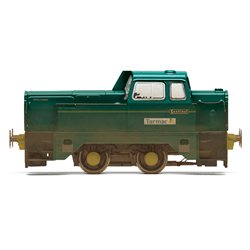No products
Valid to UK only
Valid to UK only
 View larger
View larger Tarmac 4wDM Sentinel Industrial Shunter Weathered
R3180
New product
Tarmac 4wDM Sentinel Industrial Shunter Weathered
- Class: Sentinel
- Designer: Sentinel
- Entered Service: 1963
- Purpose: Industrial
- Wheel Configuration: 4wDM
- Dimensions: 98mm
- Livery: Tarmac
- Finish: Weathered
This product is no longer in stock
Data sheet
| Scale | OO (1/76) |
More info
Tarmac 4wDM Sentinel Industrial Shunter Weathered
- Class: Sentinel
- Designer: Sentinel
- Entered Service: 1963
- Purpose: Industrial
- Wheel Configuration: 4wDM
- Dimensions: 98mm
- Livery: Tarmac
- Finish: Weathered
DCC Ready: For DCC Conversion use the Hornby X9659 4 Pin Decoder Chip
A Brief History
Trainspotters have for some reason never been regarded as the socially elite of British society. Their habits, demeanour and dress have often caused puzzlement and even dismay to the travelling public, as they are seen clustered together in all weathers at the end of draughty platforms with their notebooks, small bags, cameras and train recording equipment. The term "gricers" is often used to describe them, as is the term "ganglys" - Green Anoraks No Girlyfriend Yet. Still, your writer has a theory that secretly they are much liked by their women folk - harmless, submissive and playing an unsung role within society. The Sentinal locos could be seen in that light. They had a role to play, and played it, never straying from their base, never seeking the limelight, but a surprisingly efficient and significant part of the industrial railway scene for many years!
Built in the 1960s, the Sentinals were put together by Thomas Hill of Rotherham as basic shunting locomotives. They actually followed on from the Sentinal steam class which were last produced in 1958. Sightings by enthusiasts tended to be few and far between, as they never ventured on to the national network. The largest concentrations were at the Shell sites at Ellesmere Port and on the Isle of Grain, as well on British Steel and National Coal Board sites. Quite a few were built for work abroad, particularly in Africa
Built in the 1960s, the Sentinals were put together by Thomas Hill of Rotherham as basic shunting locomotives. They actually followed on from the Sentinal steam class which were last produced in 1958. Sightings by enthusiasts tended to be few and far between, as they never ventured on to the national network. The largest concentrations were at the Shell sites at Ellesmere Port and on the Isle of Grain, as well on British Steel and National Coal Board sites. Quite a few were built for work abroad, particularly in Africa.


